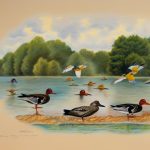Arkansas is home to a variety of duck breeds, each with its own unique characteristics and traits. Some of the most popular Arkansas duck breeds include the Khaki Campbell, the Indian Runner, and the White Crested. These breeds are known for their adaptability, hardiness, and excellent egg-laying abilities. Arkansas duck breeds are a popular choice for both backyard hobbyists and commercial farmers due to their versatility and ease of care. Whether you are a seasoned duck enthusiast or a beginner looking to raise ducks for the first time, understanding the different Arkansas duck breeds and how to care for their babies is essential for their health and well-being.
Key Takeaways
- Arkansas is home to several unique duck breeds, each with its own characteristics and traits.
- Identifying Arkansas duck breeds as babies can be challenging, but there are key features to look for in each breed.
- Caring for Arkansas duck breed babies involves providing proper nutrition, warmth, and protection from predators.
- There are distinct differences between Arkansas duck breeds as babies, including size, color, and behavior.
- Common health issues in Arkansas duck breed babies include respiratory infections and parasites, so regular check-ups are important.
Identifying Arkansas Duck Breeds as Babies
Identifying Arkansas duck breeds as babies can be a challenging task, as many breeds look similar in their early stages of life. However, there are some key characteristics that can help you distinguish between different breeds. The Khaki Campbell ducklings, for example, are known for their light brown coloring and distinctive eye stripes. Indian Runner ducklings, on the other hand, have an upright stance and a slender build, making them easily recognizable. White Crested ducklings, as the name suggests, have a white crest on their heads, which sets them apart from other breeds. It is important to familiarize yourself with these distinguishing features in order to properly care for and raise Arkansas duck breed babies.
When identifying Arkansas duck breeds as babies, it is also important to consider their behavior and temperament. While some breeds may be more docile and friendly, others may be more skittish or independent. Observing the behavior of ducklings can provide valuable insight into their breed and help you tailor your care and training methods accordingly. By paying attention to both physical characteristics and behavior, you can ensure that you are providing the best possible care for your Arkansas duck breed babies.
Caring for Arkansas Duck Breed Babies
Caring for Arkansas duck breed babies requires careful attention to their basic needs, including warmth, food, water, and shelter. Ducklings are particularly vulnerable in their early stages of life and require a warm and secure environment to thrive. Providing a brooder with a heat lamp or heating pad is essential for maintaining the proper temperature for young ducklings. Additionally, ensuring access to clean water and a balanced diet of duckling starter feed is crucial for their growth and development.
In addition to meeting their physical needs, it is important to provide socialization and mental stimulation for Arkansas duck breed babies. Ducklings are social animals and benefit from interaction with humans and other ducks. Spending time with them, talking to them, and gently handling them can help build trust and confidence. Providing toys and enrichment activities can also keep them engaged and prevent boredom. By creating a nurturing and stimulating environment, you can ensure that your Arkansas duck breed babies grow up healthy and happy.
Differences Between Arkansas Duck Breeds as Babies
While Arkansas duck breed babies may share some common needs and behaviors, there are distinct differences between breeds that should be taken into consideration when caring for them. For example, Khaki Campbell ducklings are known for their high energy levels and active nature, while Indian Runner ducklings are more curious and inquisitive. White Crested ducklings may exhibit a more reserved and cautious demeanor compared to other breeds. Understanding these differences can help you tailor your care and training approach to meet the specific needs of each breed.
In addition to behavioral differences, there are also physical distinctions between Arkansas duck breed babies. Khaki Campbell ducklings have a sleek and streamlined appearance, while Indian Runner ducklings have a more upright stance and distinctive posture. White Crested ducklings, as their name suggests, have a prominent white crest on their heads that sets them apart from other breeds. By recognizing these physical and behavioral differences, you can provide individualized care for each Arkansas duck breed baby.
Common Health Issues in Arkansas Duck Breed Babies
Like all young animals, Arkansas duck breed babies are susceptible to a range of health issues that require careful monitoring and attention. One common health issue in ducklings is pasty butt, which occurs when feces stick to the vent area and can cause blockages. Regularly checking and cleaning the vent area can help prevent this condition from occurring. Another common health concern is respiratory infections, which can be caused by poor ventilation or exposure to drafts. Providing a clean and well-ventilated environment is essential for preventing respiratory issues in ducklings.
Parasites such as mites and lice can also pose a threat to the health of Arkansas duck breed babies. Regularly inspecting their feathers and skin for signs of infestation can help catch these parasites early and prevent them from spreading. Additionally, providing regular access to clean water for swimming and bathing can help keep ducklings clean and reduce the risk of parasite infestations.
Training and Socializing Arkansas Duck Breed Babies

Training and socializing Arkansas duck breed babies is an important aspect of their care that can have a lasting impact on their behavior as adults. Positive reinforcement training methods, such as using treats and praise, can help teach ducklings basic commands and behaviors. For example, teaching them to come when called or to go into their shelter at night can help establish good habits early on.
Socializing Arkansas duck breed babies involves exposing them to different environments, people, and animals in a positive and controlled manner. This can help them become more confident and adaptable as they grow older. Introducing them to new experiences gradually and providing plenty of positive interactions can help prevent fearfulness or aggression in adulthood.
By investing time and effort into training and socializing Arkansas duck breed babies, you can help shape their behavior in a positive way and ensure that they become well-adjusted adult ducks.
Conclusion and Resources for Arkansas Duck Breed Baby Care
In conclusion, caring for Arkansas duck breed babies requires a combination of knowledge, patience, and dedication. By understanding the unique characteristics of different breeds, providing for their basic needs, recognizing potential health issues, and investing in training and socialization, you can ensure that your Arkansas duck breed babies grow up healthy and happy.
For those interested in learning more about caring for Arkansas duck breed babies, there are numerous resources available including books, online forums, local agricultural extension offices, and experienced breeders. These resources can provide valuable information on breed-specific care requirements, health management, training techniques, and more.
By utilizing these resources and applying the knowledge gained from this article, you can provide the best possible care for your Arkansas duck breed babies and enjoy the rewarding experience of raising these unique and fascinating birds.
If you’re interested in learning more about raising duck breeds as babies, you might also want to check out this helpful article on how to insulate a chicken coop. Proper insulation is crucial for creating a comfortable and safe environment for your ducklings as they grow. This article provides valuable tips and techniques for insulating your coop effectively, ensuring that your ducklings stay warm and healthy during the colder months.
FAQs
What are the different duck breeds found in Arkansas?
The most common duck breeds found in Arkansas include the Mallard, Wood Duck, Northern Pintail, Gadwall, and Green-winged Teal.
What do baby ducks look like?
Baby ducks, also known as ducklings, are typically covered in soft down feathers that are usually yellow or brown in color. They have small, fluffy bodies and a short, stubby beak.
How do baby ducks behave?
Baby ducks are known for their playful and curious nature. They are often seen following their mother closely and exploring their surroundings. They are also known for their ability to swim and forage for food at a young age.
What do baby ducks eat?
Baby ducks primarily feed on insects, small aquatic plants, and seeds. They may also be fed commercial duckling feed by their caretakers.
How long does it take for baby ducks to mature into adults?
It typically takes about 2-3 months for baby ducks to mature into adults, at which point they will have developed their full plumage and be fully independent.
Meet Walter, the feathered-friend fanatic of Florida! Nestled in the sunshine state, Walter struts through life with his feathered companions, clucking his way to happiness. With a coop that’s fancier than a five-star hotel, he’s the Don Juan of the chicken world. When he’s not teaching his hens to do the cha-cha, you’ll find him in a heated debate with his prized rooster, Sir Clucks-a-Lot. Walter’s poultry passion is no yolk; he’s the sunny-side-up guy you never knew you needed in your flock of friends!







